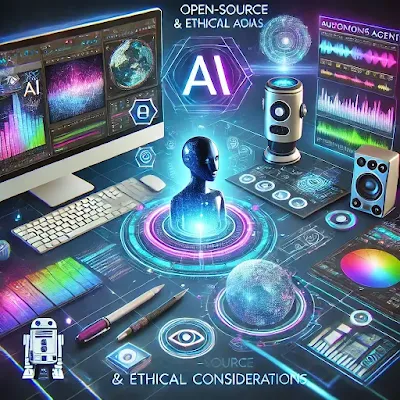The Wild Week in AI: A Deep Dive into Groundbreaking Advancements and Emerging Trends
In recent times, the rapid advancement in Artificial Intelligence (AI) has transformed from a gradual evolution to a weekly wave of breakthroughs across numerous sectors. This week's AI roundup is loaded with innovations in autonomous agents, creative tools, open-source initiatives, and the latest generative AI models, reflecting a future where AI reshapes productivity, entertainment, and even ethical discussions.
1. Major Breakthroughs in Autonomous Agents
AI's capability to perform tasks independently continues to expand, redefining automation's role across industries. One of the most remarkable advancements this week comes from Anthropic's Claude, which now has the ability to perform desktop interactions autonomously. By utilizing a cycle of screenshots, Claude processes visual information, performs the task, and verifies its completion before moving to the next step. This opens new possibilities for automating administrative and clerical tasks with minimal human intervention.
Similarly, Microsoft's Co-pilot Studio took a leap forward by enhancing its dynamic, autonomous capabilities. Users now gain visibility into agent decision-making, fostering trust and control in AI-assisted processes. Co-pilot Studio’s transparency in agent logic is vital for organizations seeking to implement AI solutions while retaining oversight on automated decisions.
2. Explosion of AI Creative Tools
This week also highlighted innovations in AI-powered creative tools designed for image and video generation. Runway’s Act One is transforming animation by synchronizing facial expressions, emotions, and spoken words with animated characters, streamlining the animation process and providing a higher degree of realism. Content creators can now focus on storytelling rather than manual animation, making high-quality animation accessible to a broader audience.
On the video generation front, open-source models like Genmo and Mochi 1 are gaining traction. These models empower users to create videos on their local devices, reducing dependency on proprietary software and enhancing control over creative output. Platforms like Fall.ai enable experimentation with these open-source tools, facilitating innovative, community-driven development in video technology.
For image creation, Stable Diffusion 3.5 has resolved issues with rendering realistic human forms and improved overall image quality and speed. This update, alongside Idiogram’s new canvas and image-editing tools, offers creators enhanced flexibility and precision in their work. Additionally, Canva’s integration with Leonardo AI’s Phoenix model further democratizes access to high-quality AI-generated images.
3. Advancements in Language Models and Accessibility
Language models continue to evolve, with several big players releasing models targeting diverse use cases. IBM’s Granite models are crafted as enterprise-focused tools, optimized to leverage internal data effectively and efficiently. The Granite models aim to match the power of larger models but are designed to provide high performance on specialized tasks, allowing businesses to tailor AI solutions to their needs.
Meta's Spirit LM introduces a new level of multimodal interactivity by processing both text and audio inputs. This capability broadens the scope of conversational AI, making it possible to interact naturally through voice and text interchangeably. Similarly, the launch of the Grok API opens opportunities for developers to embed this powerful, less-restricted language model into their applications, which could lead to innovative, creative, and unconventional tools.
4. Emphasis on Open-Source Models
Open-source projects are revolutionizing accessibility in AI by providing sophisticated tools that can be freely modified. Open-source video generation models like Mochi 1 enable community-driven experimentation, fostering innovation beyond the constraints of commercial models. The customization and experimentation allowed by these models attract developers, researchers, and hobbyists looking to push AI’s limits.
Additionally, Stable Diffusion 3.5 and other open-source image generation models empower users by offering high-quality alternatives to proprietary software, encouraging a diverse range of applications. This democratization of AI tools encourages faster iteration and a collaborative approach to problem-solving in AI development.
Ethical Considerations in AI Advancements
While the rapid progression in AI is creating a wealth of opportunities, it also brings ethical challenges to the forefront. As AI models become more capable of independent operation, concerns around privacy, security, and accountability arise. For instance, Anthropic’s Claude and similar autonomous agents bring up questions regarding control over sensitive data and the potential for misuse if not adequately safeguarded.
Moreover, the open-source nature of certain models raises the issue of content regulation. Unrestricted access to video generation tools like Mochi 1 might enable the creation of uncensored or potentially harmful content. As AI technology continues to democratize, these concerns underscore the importance of developing ethical guidelines and implementing safety measures to protect users and mitigate risks.
Key Takeaways from This Week’s AI News
This week’s developments highlight several key trends in AI:
AI’s Autonomous Leap: Tools like Claude and Co-pilot Studio show that AI is moving towards performing complex tasks with minimal oversight, which could streamline operations across many industries.
Creative Tools Flourish: From animation tools like Act One to advancements in image generation with Stable Diffusion 3.5, AI is opening doors for creative expression and innovation.
Push for Open Source and Accessibility: Open-source models like Mochi 1 offer an alternative to closed-source tools, allowing developers to build custom solutions and experiment with AI in unprecedented ways.
Ethical and Social Implications: The democratization of AI raises ethical questions that developers, companies, and society must address to ensure responsible use of these powerful tools.
Final Thoughts
The past week in AI demonstrates the transformative power of this technology and hints at its far-reaching potential. While each breakthrough promises a new layer of efficiency and creativity, it also challenges us to think critically about the ethical landscape in which AI operates. As developers and users navigate these exciting innovations, a balanced approach that considers both potential benefits and risks will be essential to ensure that AI continues to progress responsibly and inclusively.
In sum, as AI progresses rapidly, it’s crucial for stakeholders—from developers to end-users—to engage in meaningful discussions, creating an ethical framework that will safeguard both creativity and responsibility in AI’s future.
For more



0 Comments